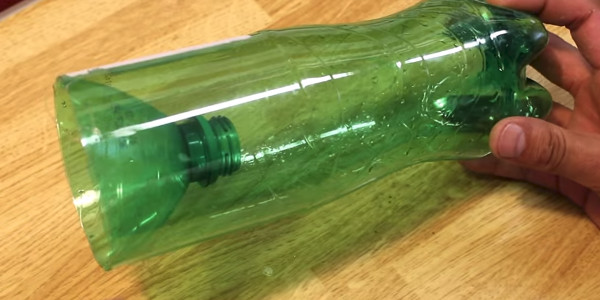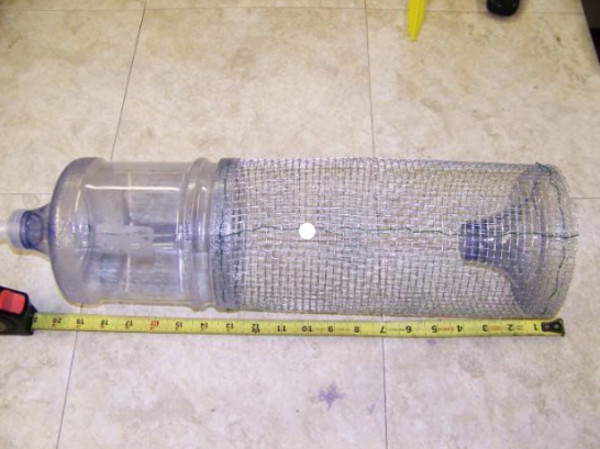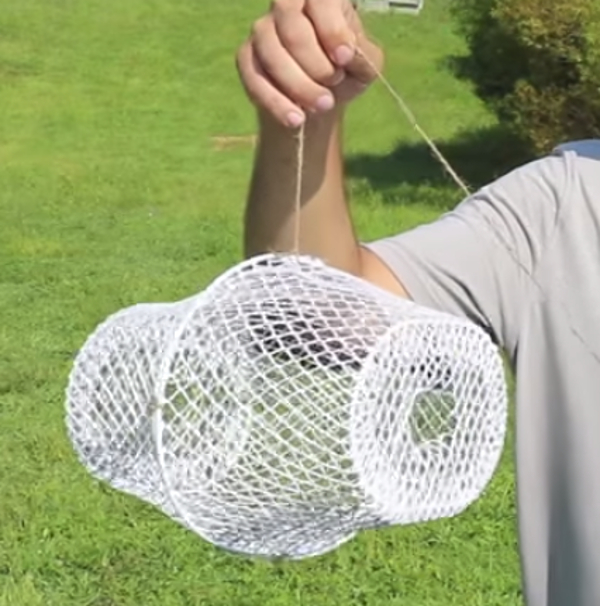Using live bait is a commonly used and very effective way of catching fish, especially highly predatory fish like pike and musky. Bass, trout, catfish, walleye and pretty much every other species of fish imaginable can be taken with live bait as well. The problem is, live bait can be a pain to catch. You could always buy minnows at a bait shop, or buy one of the commercially available minnow traps. There’s also the option of making your own.
There are a number of different homemade fish traps that are easily made. Whether you want to know how to make a fish trap to catch bait for fishing, catch food in a survival situation, or are interested in a new DIY project (maybe for your kids), you’ll learn how to make a minnow trap below.
Be sure to check you’re local regulations before setting up minnow traps in your area.
This post uses amazon affiliate links. I receive commission from any sales at no additional cost to yourself.
Bottle Trap

One of the simplest, and most common homemade minnow traps is just made out of a pop bottle and some fishing line or string. The fish are funnelled into the bottle from the inverted top of the pop bottle. The fish are able to get in, but cannot easily get out through the small hole. This same principle is used in many different commercial, homemade, and primitive fish traps and weirs.
Making this minnow trap is quite straight forward, and involves just a few steps
- Cut the top of the bottle top off.
- Cut a small strip of plastic off of the bottom of the removed bottle top.
- Poke three or four holes in both the top rim of the bottle bottom and rim of the bottle top.
- Invert the bottle top and put it in the bottle bottom as shown above.
- Tie in place with string or fishing line using the holes made earlier.
There’s a great how-to video here on how exactly to make this bottle fish trap.
Of course bottles are quite light. Even when filled with water, currents in a river may carry this trap away on you. If you want this to sink and stay put, just add some rocks or other weight to the inside of the bottle. If you want the trap suspended in the water column, you can tie some fishing line around the bottle on one end, and tie a weight to the other end.
This minnow trap design is great because it’s re-usable. The top of the bottle is only attached on one side allowing it to be opened and closed like a hatch. This allows you to easily add bait, weight, and remove fish without destroying the trap.
The materials needed for this trap are readily available, and you can likely find a bottle somewhere if you’re lost in the woods. I’m sure you have a bottle kicking around the house somewhere if you’re just interested in a cheap minnow trap.
Water Cooler Trap

This is how to make a fish trap for big fish. It’s a variation on the water bottle design above. Instead of using a pop bottle, you can use one of those big water cooler jugs you see in offices. The wire mesh extension is optional, but does allow more minnows to fit into this DIY fish trap.
It’s the same basic process to make this trap, only you’ll be attaching the two water cooler ends to the mesh wire instead of to each other.
This larger homemade fish trap is excellent for trapping suckers and other larger bait fish to use when fishing for pike or trophy musky.
Wire Basket Fish Trap

This trap almost looks like something you’d buy from a tackle shop. It’s just two wire baskets tied together with twine, so it’s very simple and easy to make. It’s also more durable, and larger than the bottle trap listed above.
Cut a hole in the bottom of one, or both of the wire baskets with a pair of pliers. After the holes have been cut, curve the metal prongs inwards to create a funnel. This again make it so that the fish can swim in, but have a difficult time swimming back out of the fish trap.
KyBassBoy has a video here explaining where he got the materials, and showing how he made this minnow trap. You could probably tweak is design a bit to make an effective crayfish trap as well. You would have to make the “funnel” more pronounced to catch crayfish effectively.
Minnow Net (Amazon Link) This is a useful net for scooping minnows out of a bait bucket.
Frabill Minnow Trap Heavy-Duty (Amazon Link) Here is a proper commercially produced minnow trap if you’d rather not mess around with making your own. They’re really quite affordable.
Where do I place the minnow trap?
Shallow bays, inlets, or weed beds are sure to hold plenty of bait fish. Sink the trap in two to four feet of water around any structure that minnows are likely to use as cover. Docks, weeds, sunken logs or trees, boulders, and other similar forms of structure are all likely to hold minnows.
Also be sure to place it somewhere that it’s easy to retrieve again. This is another reason to stick to shallow water, and you might as well place the minnow trap close to shore as well. Avoid areas with strong current, you don’t want your equipment being swept away while you wait.
If you’re afraid of losing the trap, consider adding a marker to it. Attach a small float to a piece of line and tie the line to the trap. A simple red and white fishing bobber would do the trick.
What bait should I use in my minnow traps?
Honestly, simple crackers or bread crumbs work the best for minnow bait. You want something that will dissolve a bit in the water to attract fish. Fish guts or a fish bones with some meat left on it are also good choices, especially if you chop them up a bit so little pieces of flesh float around in the water. Anything that disperses or has significant scent will attract minnows. These types of baits will also work when attracting crayfish.
Worms are generally a mediocre bait choice for minnows as they don’t break up the same way that the above baits do. If you’re dead set on using worms, you could cut them into little pieces and they’ll work okay.
If you’re using a leech trap, try using beef liver, or anything else bloody. It has to be fresh, or the bait won’t work. A fresh fish carcass (like a sunfish) will also work well. Another note on catching leeches is that unlike minnows or crayfish, they are not actually “trapped” and can leave at any time. So you have to check the trap frequently (early morning is best) if you’re trying to catch leeches.
How do I Keep Bait Minnows Alive?
You need a place to store them. An old fish tank or Rubbermaid container works if you’re keeping them put for a while. If you want to be able to move them, a large bucket can work as well.
If you don’t aerate the water, the minnows will die within a few hours (they need oxygen to live!). You need an air pump to keep them alive. There are many plug-in-wall air pumps available that were designed for the aquarium hobby. You can also get battery operated air pumps that you can bring with you fishing. These are great for either the shore angler or the boating angler using a bait livewell. The battery powered air pumps are light, affordable, and (depending on brand) quiet.
Battery Powered Air Pump (Amazon Link)
The minnows will also need clean water if kept for any amount of time. The best water to use would be from the body of water that you caught the minnows in. If that’s not realistic, you can use tap water. Just make sure to dechlorinate the water before adding it to the bait bucket. You can find dechlorinator at most pet stores. If the water is cloudy, you may need to change it, perform a 50% water change of the water in the bait bucket.
It’s also best practice to add water that’s approximately the same temperature as the water already in the bucket. Temperature can easily kill your minnows. You can try to feel the water from the tap and in the bucket to gauge if they’re the same. A better method would be to let the water sit in the same room as the container holding the minnows before adding it to ensure it’s the same temperature.
Water Dechlorinator (Amazon Link)
It’s also important to prevent the minnows from overheating. If left out in the sun, you’ll quickly find all your bait belly up. Keep them in a shaded area at home (garage or basement). When out fishing, store them in shade as well if possible. Think under a tree or the shade of a bridge.
If you plan on keeping minnows for longer than a few days, you may need a functioning aquarium to keep them. This involves proper tank set up, fish acclimatisation, a heater, water changes, filter, and all the associated practices and equipment that go into maintaining an aquarium. This is a hobby unto itself and is beyond the scope of this article. I may go into detail on this later and I’m almost as much of a fish keeping enthusiast as I am an angler.

The number of rods you can use at the same time depends on the water you’re fishing in and the fish you’re trying to catch.